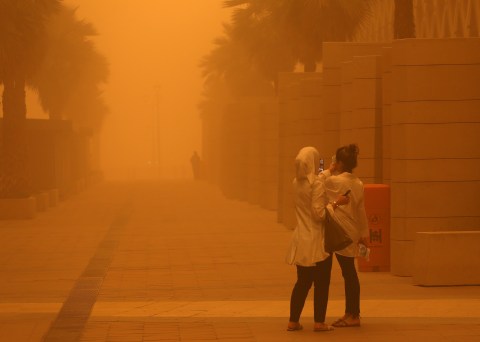Remember the unbearable heat in the UK where record-breaking temperatures reached 40C?
While spring has finally arrived in the UK, and we’re looking forward to the warmth of the sun, there is such a thing as too hot.
In one country in particular, there’s a city so hot that birds can be seen falling dead from the sky, and there’s even air conditioning outside in the streets.
Kuwait City in the Middle East is considered the hottest city on earth, hitting sweltering temperatures that reach over 50°C.
It’s so sizzling, that locals have described the heat as ‘uninhabitable’ in the summer.
What’s the weather like in Kuwait City?
The mercury starts to climb in Kuwait in May, where it then continues to spike throughout the summer months.
Kuwait City itself is a concrete metropolis, and as such, retains the heat. The city, which is known its for huge oil reserves, also sees low rainfall which make matters worse.
The highest temperature recorded by Kuwait’s Mitribah weather station, which about 90 minutes outside of Kuwait City, is a staggering 54°C.
The lack of moisture has led to sandstorms which are becoming more intense every year, making the heat feel even worse.
How do Kuwaitis cope with 50°C+ heat?
The three million residents of Kuwait City tend to stay indoors in air conditioned homes, cars and offices, and limit the amount of time they spend outside. There are also indoor shopping malls aplenty, including an entire street lined with palm trees.
ALSO READ: Veteran DJ Tony Blackburn, 81, sets record straight on claims he slept with over 250 women
Suncream and cold showers are of course a must – although the sun can warm up the pipes, meaning even the cold water is pretty toasty.
The Kuwaiti government has also allowed funerals to be held at night instead of the day to avoid the oppressive sun.
Animals aren’t so lucky when it comes to escaping the heat though – locals have reported seeing birds falling dead rom the sky, seahorses ‘cooked’ by the sea, and pigeons trying to stay alive by huddling together in the shade to keep calm.
If you head to Kuwait in the summer time, you better check under your car before driving off – it’s one of the few places stray cats and dogs can find a cooler spot to rest in.
The one positive about living in the world’s hottest city is that during the summer months, the city – and particularly the roads – are pretty quiet, with so many people leaving for long getaways, only returning when it’s cooled down.
But, even when Kuwait City is not facing record-breaking heat, average temperatures are still pretty sky high, reaching 45°C.

What does 50°C+ feel like?
When us Brits are so used to grey and miserable weather, it’s hard to comprehend what living in such sweltering conditions must feel like.
On one Quora forum, people who have experienced it, shared some eye-opening descriptions.
Abishek Mishra wrote: ‘It is UNBEARABLE. I live in Gandhinagar, Gujrat, where the temperature goes up to 50. It’s really hard to tolerate such temperatures. So when you wake up at 7–8am, you’re already bathing in sweat.
‘Next up, when you go to the bathroom for a bath, you find really damn hot water.
‘It’s like having a sauna in your bathroom.’
Another poster, Chris Mason, wrote: ‘While I was working in Oman, the runway temperature hit 50 a few times.
‘The dry heat wasn’t the biggest problem. I found it was more that the wind would pick up the gritty sand and together with the heat it felt like someone holding a hairdryer to my face.
‘It would literally burn my skin. I had to wear trousers and roll down my sleeves. And wrap around sunglasses were essential.’
What affect do high temperatures have on the human body?
According to The World Health Organization, exposure to heat is increasing due to climate change, and this trend will continue.
Globally, extreme temperature events are observed to be increasing in their frequency, duration, and magnitude. In 2015 alone, 175 million additional people were exposed to heat waves compared to average years.
Extended periods of high day and nighttime temperatures can create physiological stress on the body which exacerbates the top causes of death globally, including respiratory and cardiovascular diseases, diabetes and renal disease.
Spending time outside in such high heats is also dangerous. Exposed skin under the sun can burn, and heatstroke, headaches, and fainting are a risk, Metro said.







Be First to Comment